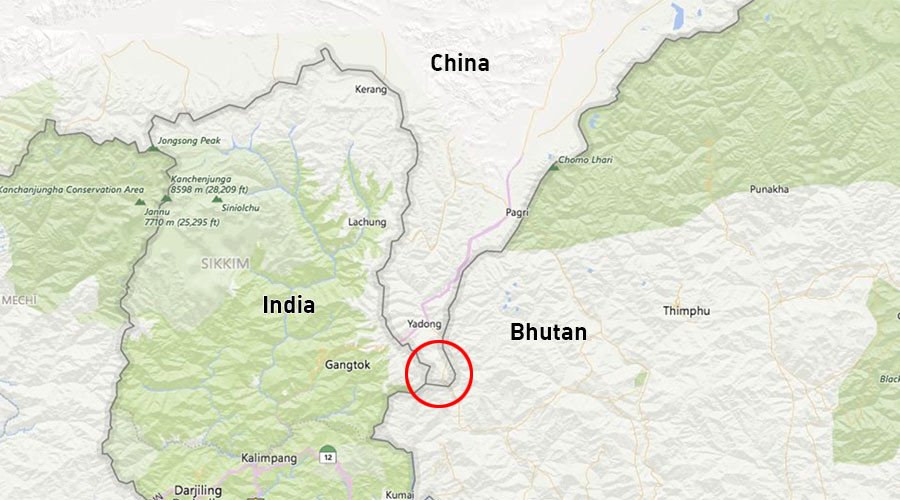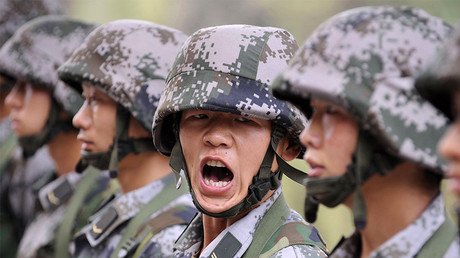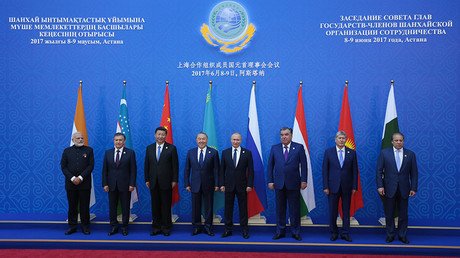China & India play ‘who blinks first’ over tiny strategic area in Himalayas

Beijing and New Delhi are standing their ground, neither side yielding an inch in a dispute over a piece of Himalayan territory that flared up again a month ago. Could a war of words in an issue with former colonial fingerprints on it evolve into all-out war?
In a statement on Wednesday, China’s Foreign Ministry reiterated its call to India, saying it must remove its forces from what Beijing considers part of its territory.
“The Indian side not only has not taken any actual steps to correct its mistake, it has concocted all sorts of reasons that don't have a leg to stand on, to make up excuses for the Indian military's illegal crossing of the border,” it said.
1. The development near the tri-junction of India-Bhutan-China should remain an ‘incident’ that can be resolved through talks.
— P. Chidambaram (@PChidambaram_IN) July 30, 2017
India says its incursion across an internationally recognized border, launched on June 18, was meant to protect its close ally Bhutan from a Chinese attempt to change the status quo in the disputed part of the Himalayas known as Doklam. The deployment was prompted by construction work by Chinese military engineers, who, according to India, attempted to extend an old road deeper into the area.
British survey mistake?
India and China, two nuclear-armed Asian powerhouses, are no strangers to border conflicts. They have a shared frontier of 3,500km, large parts of which remain disputed, and fought a bloody war in 1962 over Aksai Chin, which resulted in victory for Beijing. More recently, major Sino-Indian border incidents happened in 2013 at Depsang and in 2014 at Chumar.

But Doklam, where the borders of China, India and Bhutan meet, had not been in the world media spotlight until the current standoff erupted in mid-June. Bhutan and China have held 24 rounds of discreet talks over the status of the area since 1890, when the seeds of the dispute were planted.
The conflict stems from the 19th-century Calcutta Convention between colonial Britain and Qing dynasty China, which demarked the border between Sikkim and Tibet. Sikkim was then a British protectorate and is now an Indian state. Bhutan was not part of the convention, but China uses its wording to determine where the triboundary point should be located. The convention arguably contradicts itself, being based on erroneous data provided by a British land survey.
Road rage
The trigger point of the current conflict was China’s decision to conduct road construction in Doklam. The work started on June 16 and its exact nature remains unclear. India insists that the People’s Liberation Army (PLA) was trying to extend a road southwards in a move which would significantly change the status quo.
To prevent this, two days later the Indian military crossed the border into what China sees as its sovereign territory and what India considers part of its close ally Bhutan. Several dozen troops from each side remain gridlocked while the two capitals seem unable to make any progress on the issue.
With soldiers on standby, officials in both India and China have defended their respective positions, accusing each other of taking an aggressive stance. Some state media in China have called for India to be taught a new lesson, evoking the ghost of the 1962 war, while the PLA staged live-fire drills in Tibet in an apparent demonstration of force. Indian commentators have said their armed forces are capable of standing up to China in the Himalayas.
Bhutan has apparently tried to distance itself from India’s steps. A statement released by the kingdom’s Foreign Ministry a day after the Indian incursion didn’t even mention New Delhi at all, and merely confirmed that it viewed the road construction as a problem and an obstacle to demarking the border.
PLA flagship newspaper calls for immediate withdrawal of Indian border troops trespassing in China https://t.co/OspuhXtElapic.twitter.com/DcCeSOWNYo
— China Xinhua News (@XHNews) August 3, 2017
Bhutan has also expressed its wish to return the situation to what it was before June 16. The status quo involved regular PLA patrols in the area and Beijing’s overall de facto control of the barren land, with India keeping a strong military presence on its side of the border.
What if Bhutan merge with India as New State? I think Why not? like Sikkim became the 22nd Indian State on 26 April 1975.
— Anshul Saxena (@AskAnshul) July 24, 2017
Where will the conflict evolve?
The border confrontation is unlikely to lead to a major armed conflict between China and India, Dr. Sreeram Sundar Chaulia, professor at the Jindal School of International Affairs, told RT.
“What will happen is not full-scale war but an extended period of saber-rattling, followed by a face-saving solution (a step-by-step de-escalation where both armies will withdraw from Doklam after claiming that they achieved their respective strategic goals),” he predicted, saying that a war would be too costly either nation to allow the situation escalate.
He said the Doklam incident highlights the importance of final demarcation of borders in the region, which India and China has failed to do despite decades of negotiations.
“The biggest issue is the overall competition for power and the overlapping zones of contestation between India and China, which go beyond the border and extend to the maritime arena in the South China Sea and the Indian Ocean,” Chaulia added.
“The sense of rivalry and insecurity created by the outward push of both countries to expand their spheres of influence will lead to continued problems in the future.”
Both India and China are member-states of the Shanghai Cooperation Organization as well as members of BRICS, the association of five major emerging national economies. This will help prevent an all-out conflict as economic considerations will prevail, says geopolitical analyst Patrick Henningsen.
According to Henningsen, "the likelihood of this escalating into a hot war seems unlikely, and the benefits of Indian-Sino cooperation in trade and defense seem like they would trump what would be relatively minor unilateral strategic gains China might make by seizing this part of the Doklam."
He believes that "India actually has some leverage after joining the Shanghai Cooperation Organization - economic development is predicated on cooperation and 'strength in numbers'. If India were to leave the SCO it would certainly weaken it, which would be a negative outcome for China, therefore, India has a strong negotiating hand to play there."
However, this could be one of the most complex three-way international border situations on Earth.
"When you look back as to what is the root cause of this border dispute between the two countries, not surprisingly, and like so many other generational quagmires (like Iraq, Syria, Egypt and Palestine) we find former colonial fingerprints on the situation," Henningsen says, adding that both India and China's respective claims are based on differing interpretations of the 1890 Calcutta Convention.
"Blame history for this one: with former colonial possessions the world over, it seems there's no end to these types of territorial disputes. If Bhutan is not up for mediating this dispute, will we see the UK or US impose itself as part of the arbitration panel, or will this trigger a UN Resolution or a UN-imposed neutral zone?" he concludes.














